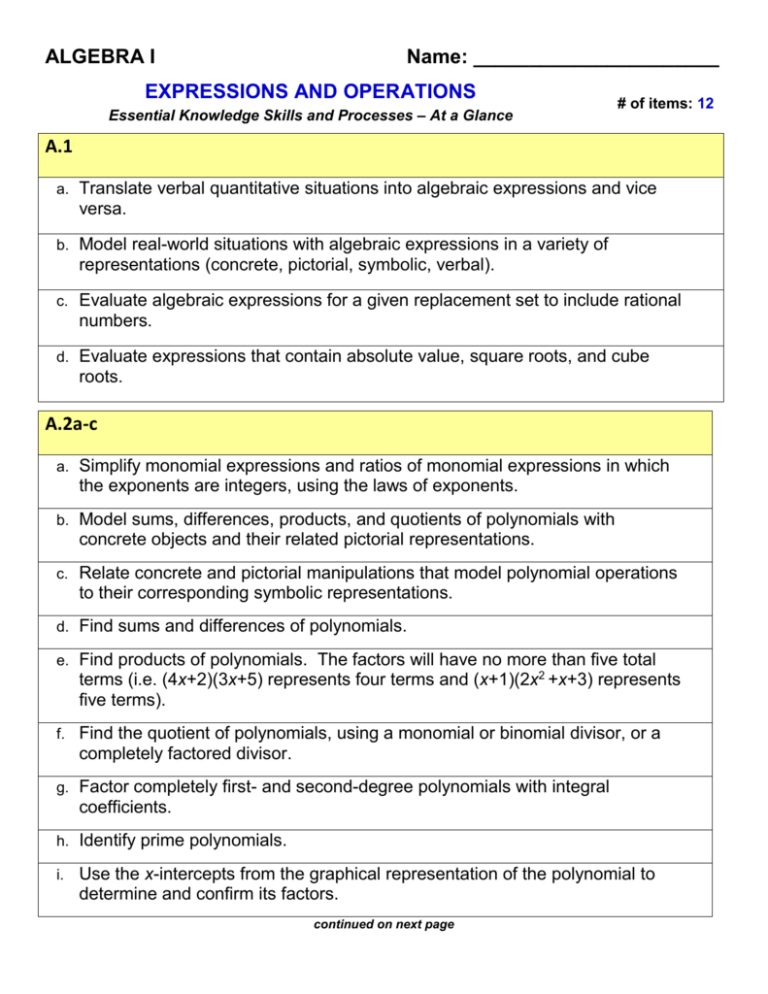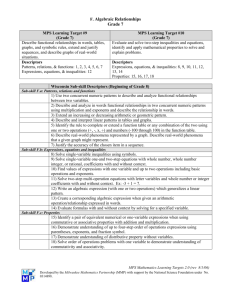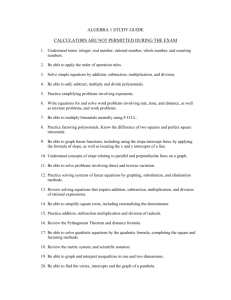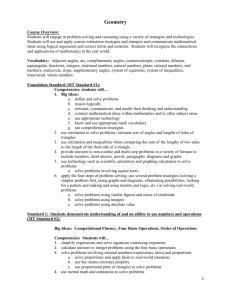EOC Math EKS At a Glance
advertisement

ALGEBRA I Name: ______________________ EXPRESSIONS AND OPERATIONS Essential Knowledge Skills and Processes – At a Glance # of items: 12 A.1 a. Translate verbal quantitative situations into algebraic expressions and vice versa. b. Model real-world situations with algebraic expressions in a variety of representations (concrete, pictorial, symbolic, verbal). c. Evaluate algebraic expressions for a given replacement set to include rational numbers. d. Evaluate expressions that contain absolute value, square roots, and cube roots. A.2a-c a. Simplify monomial expressions and ratios of monomial expressions in which the exponents are integers, using the laws of exponents. b. Model sums, differences, products, and quotients of polynomials with concrete objects and their related pictorial representations. c. Relate concrete and pictorial manipulations that model polynomial operations to their corresponding symbolic representations. d. Find sums and differences of polynomials. e. Find products of polynomials. The factors will have no more than five total terms (i.e. (4x+2)(3x+5) represents four terms and (x+1)(2x2 +x+3) represents five terms). f. Find the quotient of polynomials, using a monomial or binomial divisor, or a completely factored divisor. g. Factor completely first- and second-degree polynomials with integral coefficients. h. Identify prime polynomials. i. Use the x-intercepts from the graphical representation of the polynomial to determine and confirm its factors. continued on next page ALGEBRA I Name: _________________________ page 2 of 2 A.3 a. Express square roots of a whole number in simplest form. b. Express the cube root of a whole number in simplest form. c. Express the principal square root of a monomial algebraic expression in simplest form where variables are assumed to have positive values. ALGEBRA I Name: ______________________ EQUATIONS AND INEQUALITIES Essential Knowledge Skills and Processes – At a Glance # of items: 18 A.4a-f a. Solve a literal equation (formula) for a specified variable. b. Simplify expressions and solve equations, using the field properties of the real numbers and properties of equality to justify simplification and solution. c. Solve quadratic equations. d. Identify the roots or zeros of a quadratic function over the real number system as the solution(s) to the quadratic equation that is formed by setting the given quadratic expression equal to zero. e. Solve multistep linear equations in one variable. f. Confirm algebraic solutions to linear and quadratic equations, using a graphing calculator. g. Given a system of two linear equations in two variables that has a unique solution, solve the system by substitution or elimination to find the ordered pair which satisfies both equations. h. Given a system of two linear equations in two variables that has a unique solution, solve the system graphically by identifying the point of intersection. i. Determine whether a system of two linear equations has one solution, no solution, or infinite solutions. j. Write a system of two linear equations that models a real-world situation. k. Interpret and determine the reasonableness of the algebraic or graphical solution of a system of two linear equations that models a real-world situation. l. Determine if a linear equation in one variable has one, an infinite number, or no solutions.† continued on next page ALGEBRA I page 2 of 2 Name: __________________________ A.5a-d a. Solve multistep linear inequalities in one variable. b. Justify steps used in solving inequalities, using axioms of inequality and properties of order that are valid for the set of real numbers. c. Solve real-world problems involving inequalities. d. Solve systems of linear inequalities algebraically and graphically. A.6a-b a. Graph linear equations and inequalities in two variables, including those that arise from a variety of real-world situations. b. Use the parent function y = x and describe transformations defined by changes in the slope or y-intercept. c. Find the slope of the line, given the equation of a linear function. d. Find the slope of a line, given the coordinates of two points on the line. e. Find the slope of a line, given the graph of a line. f. Recognize and describe a line with a slope that is positive, negative, zero, or undefined. g. Use transformational graphing to investigate effects of changes in equation parameters on the graph of the equation. h. Write equation of a line when given the graph of a line. i. Write an equation of a line when given two points on the line whose coordinates are integers. j. Write an equation of a line when given the slope and a point on the line whose coordinates are integers. k. Write an equation of a vertical line as x = a. l. Write the equation of a horizontal line as y = c. ALGEBRA I Name: ______________________ FUNCTIONS AND STATISTICS Essential Knowledge Skills and Processes – At a Glance # of items: 20 A.7a-f a. Solve a literal equation (formula) for a specified variable. b. Simplify expressions and solve equations, using the field properties of the real numbers and properties of equality to justify simplification and solution. c. Solve quadratic equations. d. Identify the roots or zeros of a quadratic function over the real number system as the solution(s) to the quadratic equation that is formed by setting the given quadratic expression equal to zero. e. Solve multistep linear equations in one variable. f. Confirm algebraic solutions to linear and quadratic equations, using a graphing calculator. g. Given a system of two linear equations in two variables that has a unique solution, solve the system by substitution or elimination to find the ordered pair which satisfies both equations. h. Given a system of two linear equations in two variables that has a unique solution, solve the system graphically by identifying the point of intersection. i. Determine whether a system of two linear equations has one solution, no solution, or infinite solutions. j. Write a system of two linear equations that models a real-world situation. k. Interpret and determine the reasonableness of the algebraic or graphical solution of a system of two linear equations that models a real-world situation. l. Determine if a linear equation in one variable has one, an infinite number, or no solutions.† continued on next page ALGEBRA I page 2 of 2 Name: __________________________ A.5a-d a. Solve multistep linear inequalities in one variable. b. Justify steps used in solving inequalities, using axioms of inequality and properties of order that are valid for the set of real numbers. c. Solve real-world problems involving inequalities. d. Solve systems of linear inequalities algebraically and graphically. A.6a-b a. Graph linear equations and inequalities in two variables, including those that arise from a variety of real-world situations. b. Use the parent function y = x and describe transformations defined by changes in the slope or y-intercept. c. Find the slope of the line, given the equation of a linear function. d. Find the slope of a line, given the coordinates of two points on the line. e. Find the slope of a line, given the graph of a line. f. Recognize and describe a line with a slope that is positive, negative, zero, or undefined. g. Use transformational graphing to investigate effects of changes in equation parameters on the graph of the equation. h. Write equation of a line when given the graph of a line. i. Write an equation of a line when given two points on the line whose coordinates are integers. j. Write an equation of a line when given the slope and a point on the line whose coordinates are integers. k. Write an equation of a vertical line as x = a. l. Write the equation of a horizontal line as y = c. GEOMETRY Name: ______________________ REASONING, LINES, AND TRANSFORMATIONS # of items: 18 Essential Knowledge Skills and Processes – At a Glance G.1a-d a. Identify the converse, inverse, and contrapositive of a conditional statement. b. Translate verbal arguments into symbolic form, such as (p q) and (~p ~q). c. Determine the validity of a logical argument. d. Use valid forms of deductive reasoning, including the law of syllogism, the law of the contrapositive, the law of detachment, and counterexamples. e. Select and use various types of reasoning and methods of proof, as appropriate. f. Use Venn diagrams to represent set relationships, such as intersection and union. g. Interpret Venn diagrams. h. Recognize and use the symbols of formal logic, which include →, ↔, ~, , , and . G.2a-c a. Use algebraic and coordinate methods as well as deductive proofs to verify whether two lines are parallel. b. Solve problems by using the relationships between pairs of angles formed by the intersection of two parallel lines and a transversal including corresponding angles, alternate interior angles, alternate exterior angles, and same-side (consecutive) interior angles. c. Solve real-world problems involving intersecting and parallel lines in a plane. continued on next page GEOMETRY Name: _________________________ page 2 of 2 G.3a-d a. Find the coordinates of the midpoint of a segment, using the midpoint formula. b. Use a formula to find the slope of a line. c. Compare the slopes to determine whether two lines are parallel, perpendicular, or neither. d. Determine whether a figure has point symmetry, line symmetry, both, or neither. e. Given an image and preimage, identify the transformation that has taken place as a reflection, rotation, dilation, or translation. f. Apply the distance formula to find the length of a line segment when given the coordinates of the endpoints. G.4a-g a. Construct and justify the constructions of 1. 2. 3. 4. 5. 6. 7. a line segment congruent to a given line segment; the perpendicular bisector of a line segment; a perpendicular to a given line from a point not on the line; a perpendicular to a given line at a point on the line; the bisector of a given angle; an angle congruent to a given angle; and a line parallel to a given line through a point not on the given line. b. Construct an equilateral triangle, a square, and a regular hexagon inscribed in a circle.† c. Construct the inscribed and circumscribed circles of a triangle.† d. Construct a tangent line from a point outside a given circle to the circle. † GEOMETRY Name: ______________________ TRIANGLES Essential Knowledge Skills and Processes – At a Glance # of items: 14 G.5a-d a. Order the sides of a triangle by their lengths when given the measures of the angles. b. Order the angles of a triangle by their measures when given the lengths of the sides. c. Given the lengths of three segments, determine whether a triangle could be formed. d. Given the lengths of two sides of a triangle, determine the range in which the length of the third side must lie. e. Solve real-world problems given information about the lengths of sides and/or measures of angles in triangles. G.6 a. Use definitions, postulates, and theorems to prove triangles congruent. b. Use coordinate methods, such as the distance formula and the slope formula, to prove two triangles are congruent. c. Use algebraic methods to prove two triangles are congruent. G.7 a. Use definitions, postulates, and theorems to prove triangles similar. b. Use algebraic methods to prove that triangles are similar. c. Use coordinate methods, such as the distance formula, to prove two triangles are similar. continued on next page GEOMETRY Name: _________________________ page 2 of 2 G.8 a. Determine whether a triangle formed with three given lengths is a right triangle. b. Solve for missing lengths in geometric figures, using properties of 45-45-90 triangles. c. Solve for missing lengths in geometric figures, using properties of 30-60-90 triangles. d. Solve problems involving right triangles, using sine, cosine, and tangent ratios. e. Solve real-world problems, using right triangle trigonometry and properties of right triangles. f. Explain and use the relationship between the sine and cosine of complementary angles.† GEOMETRY Name: ______________________ POLYGONS, CIRCLES, AND THREE-DIMENSIONAL FIGURES Essential Knowledge Skills and Processes – At a Glance # of items: 18 G.9 a. Solve problems, including real-world problems, using the properties specific to parallelograms, rectangles, rhombi, squares, isosceles trapezoids, and trapezoids. b. Prove that quadrilaterals have specific properties, using coordinate and algebraic methods, such as the distance formula, slope, and midpoint formula. c. Prove the characteristics of quadrilaterals, using deductive reasoning, algebraic, and coordinate methods. d. Prove properties of angles for a quadrilateral inscribed in a circle. † G.10 a. Solve real-world problems involving the measures of interior and exterior angles of polygons. b. Identify tessellations in art, construction, and nature. c. Find the sum of the measures of the interior and exterior angles of a convex polygon. d. Find the measure of each interior and exterior angle of a regular polygon. e. Find the number of sides of a regular polygon, given the measures of interior or exterior angles of the polygon. continued on next page GEOMETRY Name: _________________________ page 2 of 3 G.11a-c a. Find lengths, angle measures, and arc measures associated with 1. 2. 3. 4. 5. two intersecting chords; two intersecting secants; an intersecting secant and tangent; two intersecting tangents; and central and inscribed angles. b. Calculate the area of a sector and the length of an arc of a circle, using proportions. c. Solve real-world problems associated with circles, using properties of angles, lines, and arcs. d. Verify properties of circles, using deductive reasoning, algebraic, and coordinate methods. G.12 a. Identify the center, radius, and diameter of a circle from a given standard equation. b. Use the distance formula to find the radius of a circle. c. Given the coordinates of the center and radius of the circle, identify a point on the circle. d. Given the equation of a circle in standard form, identify the coordinates of the center and find the radius of the circle. e. Given the coordinates of the endpoints of a diameter, find the equation of the circle. f. Given the coordinates of the center and a point on the circle, find the equation of the circle. g. Recognize that the equation of a circle of given center and radius is derived using the Pythagorean Theorem.† continued on next page GEOMETRY page 3 of 3 Name: __________________________ G.13 a. Find the total surface area of cylinders, prisms, pyramids, cones, and spheres, using the appropriate formulas b. Calculate the volume of cylinders, prisms, pyramids, cones, and spheres, using the appropriate formulas. c. Solve problems, including real-world problems, involving total surface area and volume of cylinders, prisms, pyramids, cones, and spheres as well as combinations of three-dimensional figures. d. Calculators may be used to find decimal approximations for results. G.14a-d a. Compare ratios between side lengths, perimeters, areas, and volumes, given two similar figures. b. Describe how changes in one or more dimensions affect other derived measures (perimeter, area, total surface area, and volume) of an object. c. Describe how changes in one or more measures (perimeter, area, total surface area, and volume) affect other measures of an object. d. Solve real-world problems involving measured attributes of similar objects.. ALGEBRA II Name: ______________________ EXPRESSIONS AND OPERATIONS Essential Knowledge Skills and Processes – At a Glance # of items: 13 AII.1a-d a. Add, subtract, multiply, and divide rational algebraic expressions. b. Simplify a rational algebraic expression with common monomial or binomial factors. c. Recognize a complex algebraic fraction, and simplify it as a quotient or product of simple algebraic fractions. d. Simplify radical expressions containing positive rational numbers and variables. e. Convert from radical notation to exponential notation, and vice versa. f. Add and subtract radical expressions. g. Multiply and divide radical expressions not requiring rationalizing the denominators. h. Factor polynomials by applying general patterns including difference of squares, sum and difference of cubes, and perfect square trinomials. i. Factor polynomials completely over the integers. j. Verify polynomial identities including the difference of squares, sum and difference of cubes, and perfect square trinomials.† continued on next page ALGEBRA II Name: _________________________ page 2 of 2 AII.3 a. Recognize that the square root of –1 is represented as i. b. Determine which field properties apply to the complex number system. c. Simplify radical expressions containing negative rational numbers and express in a+bi form. d. Simplify powers of i. e. Add, subtract, and multiply complex numbers. f. Place the following sets of numbers in a hierarchy of subsets: complex, pure imaginary, real, rational, irrational, integers, whole, and natural. g. Write a real number in a+bi form. h. Write a pure imaginary number in a+bi form. ALGEBRA II Name: ______________________ EQUATIONS AND INEQUALITIES Essential Knowledge Skills and Processes – At a Glance # of items: 13 AII.4a-d a. Solve absolute value equations and inequalities algebraically and graphically. b. Solve a quadratic equation over the set of complex numbers using an appropriate strategy. c. Calculate the discriminant of a quadratic equation to determine the number of real and complex solutions. d. Solve equations containing rational algebraic expressions with monomial or binomial denominators algebraically and graphically. e. Solve an equation containing a radical expression algebraically and graphically. f. Verify possible solutions to an equation containing rational or radical expressions. g. Apply an appropriate equation to solve a real-world problem. h. Recognize that the quadratic formula can be derived by applying the completion of squares to any quadratic equation in standard form.† AII.5 a. Predict the number of solutions to a nonlinear system of two equations. b. Solve a linear-quadratic system of two equations algebraically and graphically. c. Solve a quadratic-quadratic system of two equations algebraically and graphically. ALGEBRA II Name: ______________________ FUNCTIONS AND STATISTICS Essential Knowledge Skills and Processes – At a Glance # of items: 24 AII.2 a. Distinguish between a sequence and a series. b. Generalize patterns in a sequence using explicit and recursive formulas. c. Use and interpret the notations , n, nth term, and an. d. Given the formula, find an (the nth term) for an arithmetic or a geometric sequence. e. Given formulas, write the first n terms and find the sum, Sn, of the first n terms of an arithmetic or geometric series. f. Given the formula, find the sum of a convergent infinite series. g. Model real-world situations using sequences and series. AII.6 a. Recognize graphs of parent functions. b. Given a transformation of a parent function, identify the graph of the transformed function. c. Given the equation and using a transformational approach, graph a function. d. Given the graph of a function, identify the parent function. e. Given the graph of a function, identify the transformations that map the preimage to the image in order to determine the equation of the image. f. Using a transformational approach, write the equation of a function given its graph. continued on next page ALGEBRA II Name: __________________________ page 2 of 4 AII.7a-h a. Identify the domain, range, zeros, and intercepts of a function presented algebraically or graphically. b. Describe restricted/discontinuous domains and ranges. c. Given the graph of a function, identify intervals on which the function is increasing and decreasing. d. Find the equations of vertical and horizontal asymptotes of functions. e. Describe the end behavior of a function. f. Find the inverse of a function. g. Graph the inverse of a function as a reflection across the line y = x. h. Investigate exponential and logarithmic functions, using the graphing calculator. i. Convert between logarithmic and exponential forms of an equation with bases consisting of natural numbers. j. Find the composition of two functions. k. Use composition of functions to verify two functions are inverses. AII.8 a. Describe the relationships among solutions of an equation, zeros of a function, x-intercepts of a graph, and factors of a polynomial expression. b. Define a polynomial function, given its zeros. c. Determine a factored form of a polynomial expression from the x-intercepts of the graph of its corresponding function. d. For a function, identify zeros of multiplicity greater than 1 and describe the effect of those zeros on the graph of the function. e. Given a polynomial equation, determine the number of real solutions and nonreal solutions. continued on next page ALGEBRA II Name: ______________________________ page 3 of 4 AII.9 a. Collect and analyze data. b. Investigate scatterplots to determine if patterns exist and then identify the patterns. c. Find an equation for the curve of best fit for data, using a graphing calculator. Models will include polynomial, exponential, and logarithmic functions. d. Make predictions, using data, scatterplots, or the equation of the curve of best fit. e. Given a set of data, determine the model that would best describe the data. AII.10 a. Translate “y varies jointly as x and z” as y = kxz. b. Translate “y is directly proportional to x” as y = kx. c. Translate “y is inversely proportional to x” as y = k x. d. Given a situation, determine the value of the constant of proportionality. e. Set up and solve problems, including real-world problems, involving inverse variation, joint variation, and a combination of direct and inverse variations. continued on next page ALGEBRA II page 4 of 4 Name: __________________________ AII.11 a. Identify the properties of a normal probability distribution. b. Describe how the standard deviation and the mean affect the graph of the normal distribution. c. Compare two sets of normally distributed data using a standard normal distribution and z-scores. d. Represent probability as area under the curve of a standard normal probability distribution. e. Use the graphing calculator or a standard normal probability table to determine probabilities or percentiles based on z-scores. AII.12 a. Compare and contrast permutations and combinations. b. Calculate the number of permutations of n objects taken r at a time. c. Calculate the number of combinations of n objects taken r at a time. d. Use permutations and combinations as counting techniques to solve real- world problems.







